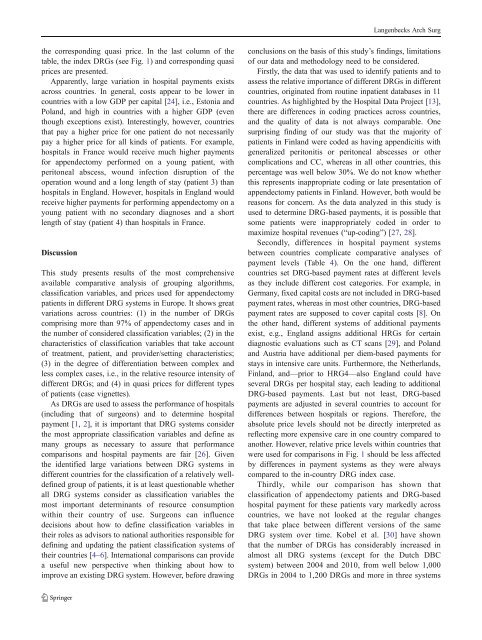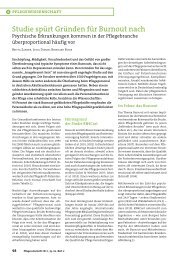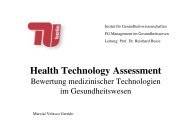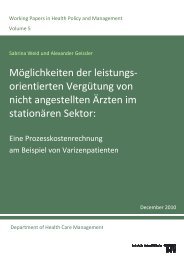Appendectomy and diagnosis-related groups (DRGs ... - TU Berlin
Appendectomy and diagnosis-related groups (DRGs ... - TU Berlin
Appendectomy and diagnosis-related groups (DRGs ... - TU Berlin
You also want an ePaper? Increase the reach of your titles
YUMPU automatically turns print PDFs into web optimized ePapers that Google loves.
the corresponding quasi price. In the last column of the<br />
table, the index <strong>DRGs</strong> (see Fig. 1) <strong>and</strong> corresponding quasi<br />
prices are presented.<br />
Apparently, large variation in hospital payments exists<br />
across countries. In general, costs appear to be lower in<br />
countries with a low GDP per capital [24], i.e., Estonia <strong>and</strong><br />
Pol<strong>and</strong>, <strong>and</strong> high in countries with a higher GDP (even<br />
though exceptions exist). Interestingly, however, countries<br />
that pay a higher price for one patient do not necessarily<br />
pay a higher price for all kinds of patients. For example,<br />
hospitals in France would receive much higher payments<br />
for appendectomy performed on a young patient, with<br />
peritoneal abscess, wound infection disruption of the<br />
operation wound <strong>and</strong> a long length of stay (patient 3) than<br />
hospitals in Engl<strong>and</strong>. However, hospitals in Engl<strong>and</strong> would<br />
receive higher payments for performing appendectomy on a<br />
young patient with no secondary diagnoses <strong>and</strong> a short<br />
length of stay (patient 4) than hospitals in France.<br />
Discussion<br />
This study presents results of the most comprehensive<br />
available comparative analysis of grouping algorithms,<br />
classification variables, <strong>and</strong> prices used for appendectomy<br />
patients in different DRG systems in Europe. It shows great<br />
variations across countries: (1) in the number of <strong>DRGs</strong><br />
comprising more than 97% of appendectomy cases <strong>and</strong> in<br />
the number of considered classification variables; (2) in the<br />
characteristics of classification variables that take account<br />
of treatment, patient, <strong>and</strong> provider/setting characteristics;<br />
(3) in the degree of differentiation between complex <strong>and</strong><br />
less complex cases, i.e., in the relative resource intensity of<br />
different <strong>DRGs</strong>; <strong>and</strong> (4) in quasi prices for different types<br />
of patients (case vignettes).<br />
As <strong>DRGs</strong> are used to assess the performance of hospitals<br />
(including that of surgeons) <strong>and</strong> to determine hospital<br />
payment [1, 2], it is important that DRG systems consider<br />
the most appropriate classification variables <strong>and</strong> define as<br />
many <strong>groups</strong> as necessary to assure that performance<br />
comparisons <strong>and</strong> hospital payments are fair [26]. Given<br />
the identified large variations between DRG systems in<br />
different countries for the classification of a relatively welldefined<br />
group of patients, it is at least questionable whether<br />
all DRG systems consider as classification variables the<br />
most important determinants of resource consumption<br />
within their country of use. Surgeons can influence<br />
decisions about how to define classification variables in<br />
their roles as advisors to national authorities responsible for<br />
defining <strong>and</strong> updating the patient classification systems of<br />
their countries [4–6]. International comparisons can provide<br />
a useful new perspective when thinking about how to<br />
improve an existing DRG system. However, before drawing<br />
Langenbecks Arch Surg<br />
conclusions on the basis of this study’s findings, limitations<br />
of our data <strong>and</strong> methodology need to be considered.<br />
Firstly, the data that was used to identify patients <strong>and</strong> to<br />
assess the relative importance of different <strong>DRGs</strong> in different<br />
countries, originated from routine inpatient databases in 11<br />
countries. As highlighted by the Hospital Data Project [13],<br />
there are differences in coding practices across countries,<br />
<strong>and</strong> the quality of data is not always comparable. One<br />
surprising finding of our study was that the majority of<br />
patients in Finl<strong>and</strong> were coded as having appendicitis with<br />
generalized peritonitis or peritoneal abscesses or other<br />
complications <strong>and</strong> CC, whereas in all other countries, this<br />
percentage was well below 30%. We do not know whether<br />
this represents inappropriate coding or late presentation of<br />
appendectomy patients in Finl<strong>and</strong>. However, both would be<br />
reasons for concern. As the data analyzed in this study is<br />
used to determine DRG-based payments, it is possible that<br />
some patients were inappropriately coded in order to<br />
maximize hospital revenues (“up-coding”) [27, 28].<br />
Secondly, differences in hospital payment systems<br />
between countries complicate comparative analyses of<br />
payment levels (Table 4). On the one h<strong>and</strong>, different<br />
countries set DRG-based payment rates at different levels<br />
as they include different cost categories. For example, in<br />
Germany, fixed capital costs are not included in DRG-based<br />
payment rates, whereas in most other countries, DRG-based<br />
payment rates are supposed to cover capital costs [8]. On<br />
the other h<strong>and</strong>, different systems of additional payments<br />
exist, e.g., Engl<strong>and</strong> assigns additional HRGs for certain<br />
diagnostic evaluations such as CT scans [29], <strong>and</strong> Pol<strong>and</strong><br />
<strong>and</strong> Austria have additional per diem-based payments for<br />
stays in intensive care units. Furthermore, the Netherl<strong>and</strong>s,<br />
Finl<strong>and</strong>, <strong>and</strong>—prior to HRG4—also Engl<strong>and</strong> could have<br />
several <strong>DRGs</strong> per hospital stay, each leading to additional<br />
DRG-based payments. Last but not least, DRG-based<br />
payments are adjusted in several countries to account for<br />
differences between hospitals or regions. Therefore, the<br />
absolute price levels should not be directly interpreted as<br />
reflecting more expensive care in one country compared to<br />
another. However, relative price levels within countries that<br />
were used for comparisons in Fig. 1 should be less affected<br />
by differences in payment systems as they were always<br />
compared to the in-country DRG index case.<br />
Thirdly, while our comparison has shown that<br />
classification of appendectomy patients <strong>and</strong> DRG-based<br />
hospital payment for these patients vary markedly across<br />
countries, we have not looked at the regular changes<br />
that take place between different versions of the same<br />
DRG system over time. Kobel et al. [30] haveshown<br />
that the number of <strong>DRGs</strong> has considerably increased in<br />
almost all DRG systems (except for the Dutch DBC<br />
system) between 2004 <strong>and</strong> 2010, from well below 1,000<br />
<strong>DRGs</strong> in 2004 to 1,200 <strong>DRGs</strong> <strong>and</strong> more in three systems














